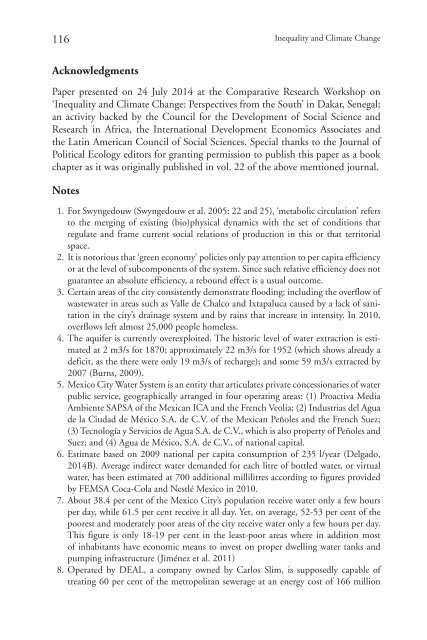Inequality and Climate Change Inégalité et changement climatique
Inequality
Inequality
Create successful ePaper yourself
Turn your PDF publications into a flip-book with our unique Google optimized e-Paper software.
116<br />
<strong>Inequality</strong> <strong>and</strong> <strong>Climate</strong> <strong>Change</strong><br />
Acknowledgments<br />
Paper presented on 24 July 2014 at the Comparative Research Workshop on<br />
‘<strong>Inequality</strong> <strong>and</strong> <strong>Climate</strong> <strong>Change</strong>: Perspectives from the South’ in Dakar, Senegal;<br />
an activity backed by the Council for the Development of Social Science <strong>and</strong><br />
Research in Africa, the International Development Economics Associates <strong>and</strong><br />
the Latin American Council of Social Sciences. Special thanks to the Journal of<br />
Political Ecology editors for granting permission to publish this paper as a book<br />
chapter as it was originally published in vol. 22 of the above mentioned journal.<br />
Notes<br />
1. For Swyngedouw (Swyngedouw <strong>et</strong> al. 2005: 22 <strong>and</strong> 25), ‘m<strong>et</strong>abolic circulation’ refers<br />
to the merging of existing (bio)physical dynamics with the s<strong>et</strong> of conditions that<br />
regulate <strong>and</strong> frame current social relations of production in this or that territorial<br />
space.<br />
2. It is notorious that ‘green economy’ policies only pay attention to per capita efficiency<br />
or at the level of subcomponents of the system. Since such relative efficiency does not<br />
guarantee an absolute efficiency, a rebound effect is a usual outcome.<br />
3. Certain areas of the city consistently demonstrate flooding; including the overflow of<br />
wastewater in areas such as Valle de Chalco <strong>and</strong> Ixtapaluca caused by a lack of sanitation<br />
in the city’s drainage system <strong>and</strong> by rains that increase in intensity. In 2010,<br />
overflows left almost 25,000 people homeless.<br />
4. The aquifer is currently overexploited. The historic level of water extraction is estimated<br />
at 2 m3/s for 1870; approximately 22 m3/s for 1952 (which shows already a<br />
deficit, as the there were only 19 m3/s of recharge); <strong>and</strong> some 59 m3/s extracted by<br />
2007 (Burns, 2009).<br />
5. Mexico City Water System is an entity that articulates private concessionaries of water<br />
public service, geographically arranged in four operating areas: (1) Proactiva Media<br />
Ambiente SAPSA of the Mexican ICA <strong>and</strong> the French Veolia; (2) Industrias del Agua<br />
de la Ciudad de México S.A. de C.V. of the Mexican Peñoles <strong>and</strong> the French Suez;<br />
(3) Tecnología y Servicios de Agua S.A. de C.V., which is also property of Peñoles <strong>and</strong><br />
Suez; <strong>and</strong> (4) Agua de México, S.A. de C.V., of national capital.<br />
6. Estimate based on 2009 national per capita consumption of 235 l/year (Delgado,<br />
2014B). Average indirect water dem<strong>and</strong>ed for each litre of bottled water, or virtual<br />
water, has been estimated at 700 additional millilitres according to figures provided<br />
by FEMSA Coca-Cola <strong>and</strong> Nestlé Mexico in 2010.<br />
7. About 38.4 per cent of the Mexico City’s population receive water only a few hours<br />
per day, while 61.5 per cent receive it all day. Y<strong>et</strong>, on average, 52-53 per cent of the<br />
poorest <strong>and</strong> moderately poor areas of the city receive water only a few hours per day.<br />
This figure is only 18-19 per cent in the least-poor areas where in addition most<br />
of inhabitants have economic means to invest on proper dwelling water tanks <strong>and</strong><br />
pumping infrastructure (Jiménez <strong>et</strong> al. 2011)<br />
8. Operated by DEAL, a company owned by Carlos Slim, is supposedly capable of<br />
treating 60 per cent of the m<strong>et</strong>ropolitan sewerage at an energy cost of 166 million





